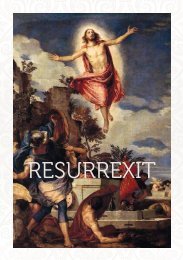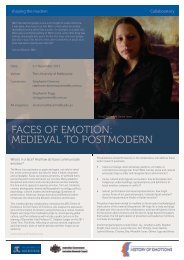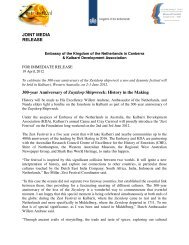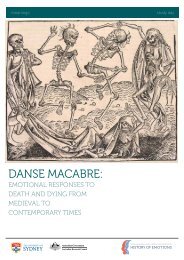Download our K-12 education pack - ARC Centre of Excellence for ...
Download our K-12 education pack - ARC Centre of Excellence for ...
Download our K-12 education pack - ARC Centre of Excellence for ...
Create successful ePaper yourself
Turn your PDF publications into a flip-book with our unique Google optimized e-Paper software.
Supporting Res<strong>our</strong>ces stories <strong>for</strong> teachers & students 2013<br />
Dutch Lives in the World<br />
stories by winthrop pr<strong>of</strong>essor susan broomhall<br />
Passions in the Music<br />
Like today’s contemporary music, in the eighteenth century there<br />
were distinct preferences in musical taste, with the different<br />
European nations focusing on different kinds <strong>of</strong> contests,<br />
instrumentation and musical <strong>for</strong>ms. Contrast was a means <strong>of</strong><br />
structuring the music: fast-slow; a large ensemble - a smaller<br />
ensemble; clean lines - heavily ornamented musical lines. All<br />
shared in the aim to create accurate musical depictions <strong>of</strong><br />
emotions. Indeed, we know that musicians at the time were<br />
praised when they were able to per<strong>for</strong>m the right emotions <strong>of</strong> the<br />
music to arouse corresponding feelings in listeners. Thus, the<br />
music was said to ‘stir the passions <strong>of</strong> the soul’. Descriptions <strong>of</strong><br />
per<strong>for</strong>mances by the Italian composer Corelli indicate reactions<br />
by the audience that we would expect to find in a contemporary<br />
pop concert - fans fainting and screaming!<br />
COUNT UNICO WILHELM VAN WASSENAER (1692-1766)<br />
This Dutch composer led a somewhat hidden musical life.<br />
He was a diplomat by pr<strong>of</strong>ession who came from an illustrious<br />
family which had served the Dutch state in times <strong>of</strong> war and<br />
peace. Van Wassenaer studied law and his musical life was<br />
unknown to scholars <strong>for</strong> a long time because, as a member <strong>of</strong><br />
the Dutch elite, he preferred not to publish his music under his<br />
own name. Indeed, he was uncertain about the musical worth<br />
<strong>of</strong> his creations, writing in a manuscript copy <strong>of</strong> his Concerti<br />
Armonici ‘Some <strong>of</strong> them are tolerable, some middling, others<br />
wretched. Had they not been published, I would perhaps have<br />
corrected the mistakes in them, but other business has left me<br />
no leisure to amuse myself with them’. This had led to some <strong>of</strong><br />
his compositions being mistakenly attributed to Italians, because<br />
van Wassenaer chose to write in that fashionable style.<br />
SYBRANT VAN NOORDT (1660-1705)<br />
Van Noordt was employed as an organist at the Oude Kerk in<br />
Amsterdam and at Sint Bavo church in Haarlem. By contrast to<br />
van Wassenaer, he was born to a family <strong>of</strong> well-connected<br />
Amsterdam artists, including his grandfather, also named Sybrant,<br />
who was a schoolmaster, organist and paid by the city to maintain<br />
its bell towers. His uncle Jan was a portrait painter, and his uncle<br />
Antonie and father Jacobus were both composers and prominent<br />
musicians at Amsterdam churches. Van Noordt’s Sonate was<br />
published by Etienne Roger around 1700 in Amsterdam, one <strong>of</strong> the<br />
main centres <strong>of</strong> music publishing at the time.<br />
WILLEM DE FESCH (1687-1761)<br />
De Fesch was a violone player and composer whose musical<br />
career took him across European states <strong>of</strong> opposing political and<br />
religious beliefs. A pupil <strong>of</strong> the Vice-Kapellmeister <strong>of</strong> Bonn, de<br />
Fesch married his teacher’s daughter, Maria Anna Rosier. He<br />
worked in Amsterdam be<strong>for</strong>e moving to Antwerp Cathedral <strong>for</strong> a<br />
position as Kapellmeister, and then to London where he played<br />
with the hugely popular German, Händel.<br />
62 FAR FROM HOME: ADVENTURES, TREKS, EXILES & MIGRATION












